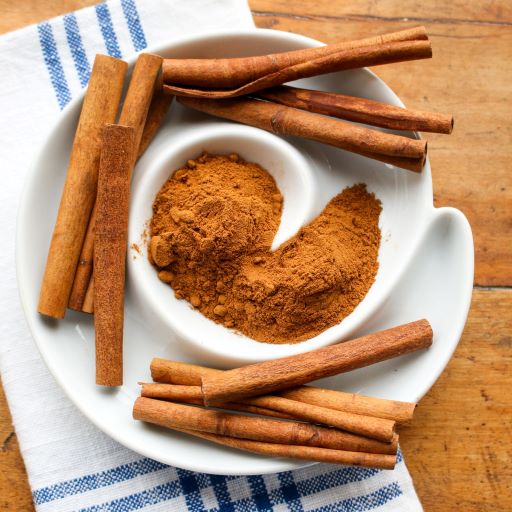How to Use Cinnamon and Cinnamon Sticks

There are health and flavor rewards in cinnamon, from cinnamon sticks and cinnamon spice to cinnamon tea and cinnamon flavored foods. Look to this expert guide, recipes, and top tips for more ways to use cinnamon and cinnamon sticks in your kitchen.
When you’re looking for an aromatic spice that brings flavor and comfort to your food, look no further than cinnamon. The sweet spice we know as cinnamon may conjure up aromatic candles or freshly baked apple pies, but there’s far more to cinnamon than meets the nose.

What is cinnamon?
Cinnamon is derived from the inner bark of certain evergreen trees from the genus Cinnamomum (cinnamon tree); the cinnamon portion of the bark is then dried to form cinnamon sticks, and ground up to form cinnamon powder. Where does cinnamon come from? Most of the world’s cinnamon is either Ceylon cinnamon or Cassia; it is cultivated mainly in Sri Lanka, China, Burma, and Vietnam (Saigon cinnamon).
Spice is life, when it comes to health too. Increasingly, research suggests that we should add a variety of flavorful herbs and spices to our diets, including cinnamon. Cinnamon’s active ingredients, including a compound called cinnamaldehyde, are credited for much of the health benefits associated with the spice. Studies show that cinnamon is rich in antioxidant and anti-inflammatory properties, which may help lower your risks of chronic diseases. You can learn more about how spicy foods, including cinnamon, can help lead to a longer lifespan at The Plant-Powered Dietitian.
Of particular interest is cinnamon’s potential role in diabetes management. In animal and test tube studies, cinnamon helped reduce cancer cell growth. Cinnamon has also been found to reduce fasting blood glucose and decrease insulin resistance, thus helping to manage and reduce the risk of diabetes (read more about cinnamon and diabetes at The Plant-Powered Dietitian). While we need more research to fully understand how cinnamon can help people manage diabetes, it’s certainly not a bad idea to include more of this flavorful spice in your diet. Try including more ground cinnamon in your cooking, including breakfast cereals, baked goods, sweets, and even savory foods, add cinnamon sticks to your morning coffee or hot chocolate, and rely on the benefits of cinnamon tea, as well.
Check out these Top 5 Ways to Use Cinnamon and Cinnamon Sticks to get cooking with cinnamon.
Top 5 Ways to Use Cinnamon and Cinnamon Sticks

1. Create a Delicious Dessert with Cinnamon as the Star
There’s a depth of flavor, taste, and aroma you can gain from desserts spiced with cinnamon. Whether it’s your grandmother’s fruit pie, snickerdoodle cookies, or a holiday cobbler, many desserts can benefit from the addition of cinnamon. Try this delicious Cinnamon Apple Crumble as a simple yet wholesome treat that beats indulgent, sugary desserts. You can use cinnamon sticks as a garnish on the side of your desserts, too.

2. Make Breakfast Fabulous with Cinnamon
During the fall and winter months—and especially during the holidays—what better way to embody warmth than an ample dose of cinnamon spice in your breakfast bowl, muffins, pancakes or waffles? Come to think of it, you can enjoy cinnamon year long to start your day! Begin with this easy recipe for Apple Cinnamon Oats for a spice-filled morning. Try throwing in a cinnamon stick while you cook your oats or soak them in overnight oats, to let it slowly release those delicious flavors.

3. Love Coffee or Tea? Top It Off with Cinnamon!
There’s really nothing like that first cup of coffee to start off your day, right? But did you know that cinnamon can take a coffee from mundane to flavor-filled in a matter of seconds? Simply sprinkle cinnamon or stir a cinnamon stick into your next coffee (or even tea) for a delicious morning beverage. For extra credit, try my delicious Homemade Pumpkin Spice Latte, which is filled with the flavors of spice, including cinnamon (a component of pumpkin pie spice). And make sure to try cinnamon tea too.

4. Discover Global Flair, Compliments of Cinnamon
Many cultural foods and dishes are centered around dynamic spices, which produce a flavor explosion for your taste buds. Foods from India, Morocco, and Brazil, among many others, use cinnamon in savory dishes. Cinnamon is often a component of spice blends, such as ras el hanout and garam masala. Try this Moroccan Chickpea Sorghum Bowl, which uses ras el hanout (a Moroccan spice blend which includes cinnamon) to maximize the tastes of cinnamon in savory recipes. Whether it’s rice pilaf or a chickpea curry, add a cinnamon stick to your pan while you sauté the onions and garlic, allowing it to infuse its flavor during the entire cooking process. Remove cinnamon sticks before serving.

5. Spice up Your Smoothie
Smoothies are a wonderful way to power up your day with delicious, whole plant foods—plus they give you the opportunity to try new flavors and additions in the mix. Just turn to your favorite smoothie recipe, such as a green smoothie, pumpkin spice smoothie, or peach zucchini carrot smoothie, and add a pinch of fabulous with cinnamon. You can also add a jaunty cinnamon stick in your smoothie glass to add flavor before serving.
For more blogs on using plant foods, check out the following:
How to Use Cherimoya
How to Cook Kohlrabi
Persimmons 101: Health Benefits Recipes and More
How to Cook All Greens
This post may contain affiliate links. For more information click here.



Wow!There are some ways I have never heard of. Thank you for sharing! It’s very interesting!